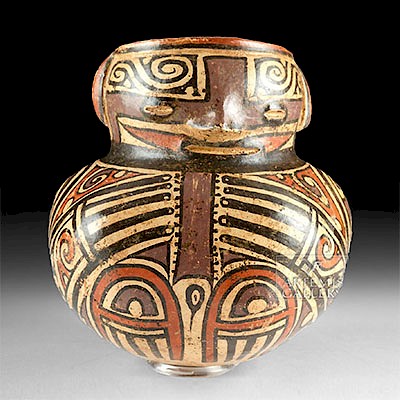Syro-Hittite Pottery Standing Female Figure
Lot 38a
About Seller
Artemis Fine Arts
686 S Taylor Ave, Ste 106
Louisville, CO 80027
United States
Selling antiquities, ancient and ethnographic art online since 1993, Artemis Gallery specializes in Classical Antiquities (Egyptian, Greek, Roman, Near Eastern), Asian, Pre-Columbian, African / Tribal / Oceanographic art. Our extensive inventory includes pottery, stone, metal, wood, glass and textil...Read more
Estimate:
$600 - $900
Absentee vs Live bid
Two ways to bid:
- Leave a max absentee bid and the platform will bid on your behalf up to your maximum bid during the live auction.
- Bid live during the auction and your bids will be submitted real-time to the auctioneer.
Bid Increments
| Price | Bid Increment |
|---|---|
| $0 | $25 |
| $300 | $50 |
| $1,000 | $100 |
| $2,000 | $250 |
| $5,000 | $500 |
| $10,000 | $1,000 |
| $20,000 | $2,500 |
| $50,000 | $5,000 |
| $100,000 | $10,000 |
| $200,000 | $20,000 |
About Auction
By Artemis Fine Arts
Nov 8, 2018
Set Reminder
2018-11-08 10:00:00
2018-11-08 10:00:00
America/New_York
Bidsquare
Bidsquare : Ancient / Ethnographic From Around The World
https://www.bidsquare.com/auctions/artemis-gallery/ancient-ethnographic-from-around-the-world-3598
Ancient art from Egypt, Greece, Italy and the Near East, as well as Asian, Pre-Columbian, Native American, African / Tribal / Oceanic, Spanish Colonial, Russian Icons, Fine art, much more! Artemis Fine Arts info@artemisgallery.com
Ancient art from Egypt, Greece, Italy and the Near East, as well as Asian, Pre-Columbian, Native American, African / Tribal / Oceanic, Spanish Colonial, Russian Icons, Fine art, much more! Artemis Fine Arts info@artemisgallery.com
- Lot Description
Ancient Near East/The Levant/Holy Land, Syria, early Middle Bronze Age I/II, ca. 2000 to 1600 BCE. A wonderful statuette of a highly-stylized woman. Such figurines were perhaps inspired by the earlier types from southern Mesopotamia, Elam, and Mari, and later became popular in Cyprus and Palestine. These statuettes always have a flat form and appear to be nude, with the legs pressed close together, separated only by a groove. The feet are undefined with a slight forward flare. Her breasts and navel are indicated by applied pellets which are sometimes pierced as we see in this example. Her arms project laterally outwards, and her bird-like face boasts a prominent nose and an elaborate headdress replete with decorative piercings. Custom museum-quality display stand included. Size: 2.2" W x 6.125" H (5.6 cm x 15.6 cm); 6.625" H (16.8 cm) on included custom stand.
Figures like this one have distinctive heads, which can have a rather bird-like appearance. They have small eyes made of pellets that are incised or drilled, and a large pinched nose; the mouth is absent, and the chin is usually absent as well or only slightly indicated. The stylized ears are pierced for the attachment of earrings, which can be made of clay or metal. Some of them have high protrusion at the center of the brow which is either pierced or has an applied pellet which is pierced. In some cases, jewelry (a necklace, a cross-band on the upper body or an ornamental girdle or hip belt) is added in metal, or represented in applied clay. The precise identity of the female depicted on these figurines remains much debated. It should be noted that many statuettes of this type were excavated from a favissa in the sacred area of Ishtar at Ebla. Experts are equally unsure of their exact function. They are believed by some to be votive offerings or amulets to a mother-goddess, whereas others call them fertility goddesses, which is questioned by some scholars because, in their view, the figures lack any exaggerated sexual anatomy. This example, however, exhibits emphasized hips and breasts which further supports the arguments of this figure being either a mother goddess or perhaps a goddess of fertility.
Provenance: private East Coast, USA collection
All items legal to buy/sell under U.S. Statute covering cultural patrimony Code 2600, CHAPTER 14, and are guaranteed to be as described or your money back.
A Certificate of Authenticity will accompany all winning bids.
We ship worldwide and handle all shipping in-house for your convenience.
#140211Both arms and top of headdress professionally reattached. Small losses to front of feet and part of belt. Minor nicks to feet, arms, body, and head, with fading to some finer features. Nice earthen deposits and light manganese blooms throughout.Condition
- Shipping Info
-
All shipping is handled in-house for your convenience. Your invoice from Artemis Gallery will include shipping calculation instructions. If in doubt, please inquire BEFORE bidding for estimated shipping costs for individual items.
-
- Buyer's Premium



 EUR
EUR CAD
CAD AUD
AUD GBP
GBP MXN
MXN HKD
HKD CNY
CNY MYR
MYR SEK
SEK SGD
SGD CHF
CHF THB
THB














